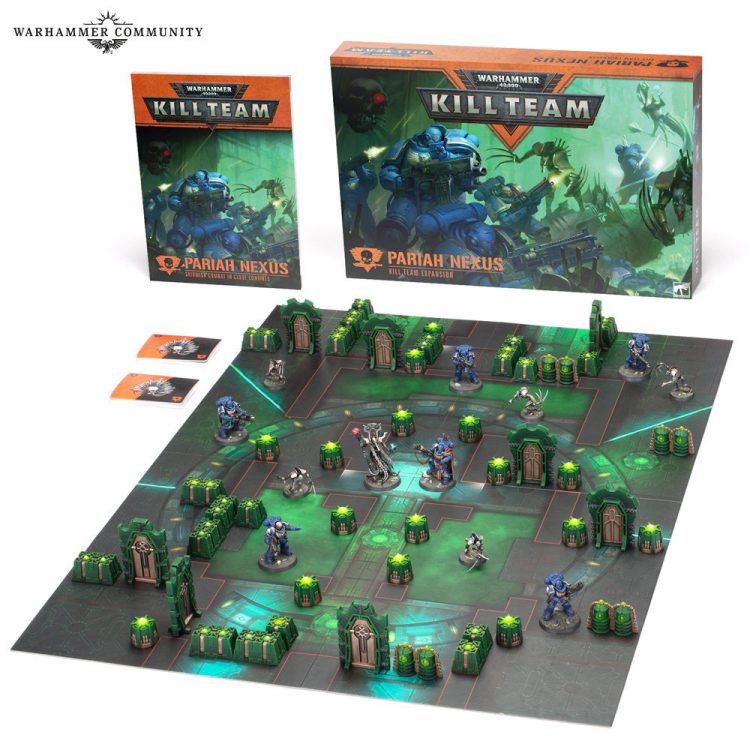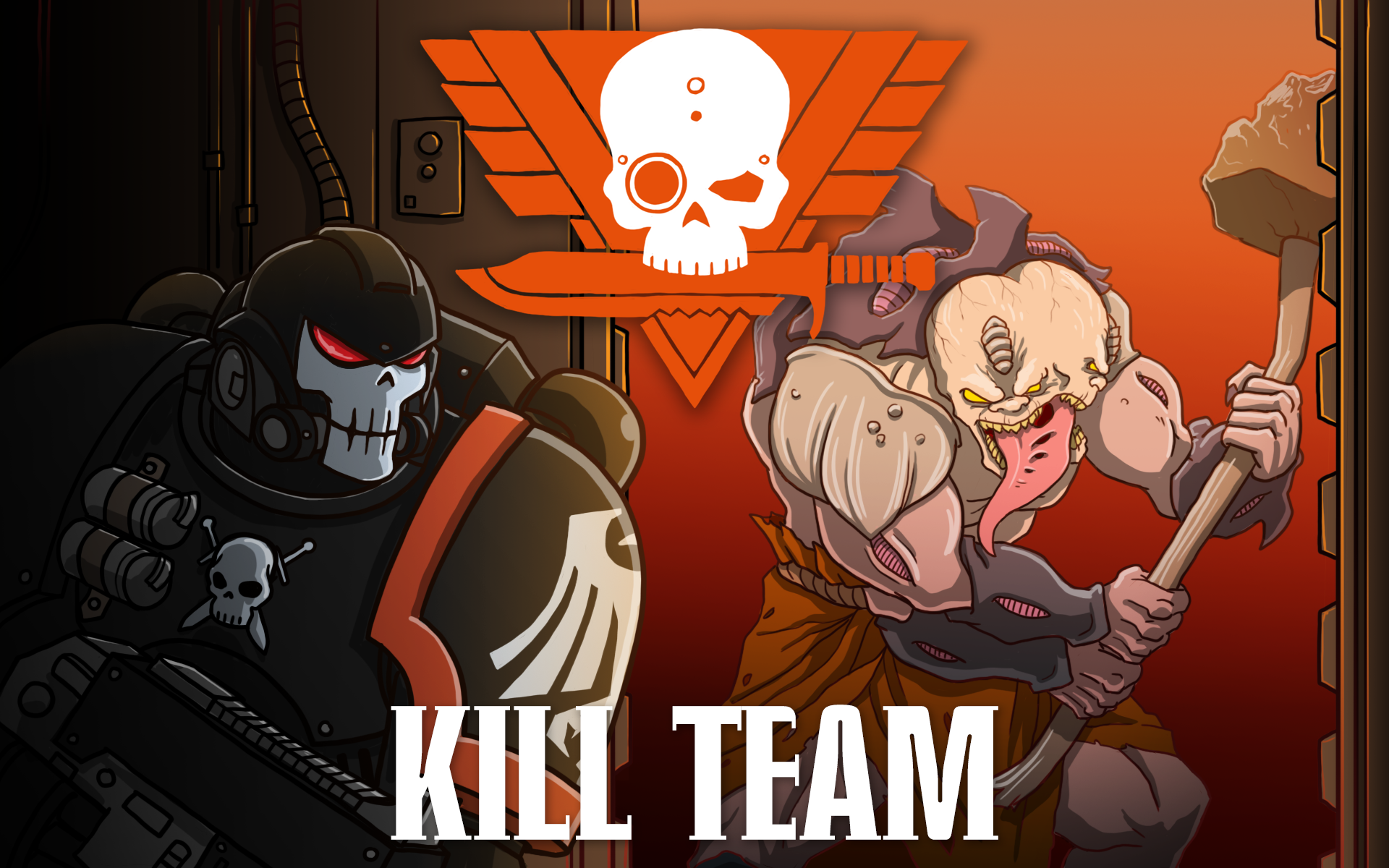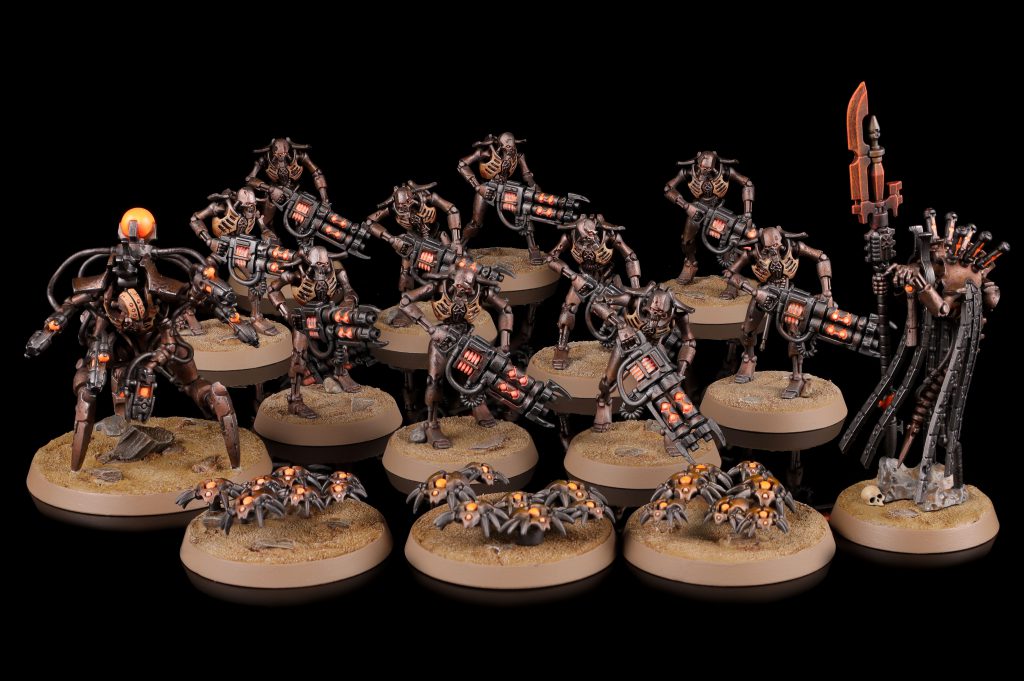One of the more surprising revelations from the Games Workshop previews in late 2020 was that we’d be seeing a new Kill Team release early this year. After more than a year without new Kill Team content – basically our last major update was the 2019 Kill Team Annual – we’re finally getting new rules and content for Kill Team! Fire up the Goonhammer presses because we have new Kill Team stuff to talk about!
What’s in the Box
The big news here is that if you’ve been waiting on Heavy Intercessors, the Chronomancer, or the new Flayed Ones, this is currently the place to get them. If you want to see the models in the new box, Liam “Corrode” Royle has an unboxing review you can find here that covers everything you’ll find and talks about the process of building it.
Welcome to the Pariah Nexus
This newest Kill Team Expansion takes place in the Pariah Nexus, placing it squarely in-line with the 9th edition launch and the related story. The book’s lore covers the Pariah Nexus and its effects on imperial citizens, gives a background on the Space Marines and Necrons, and details an Ultramarines effort to infiltrate a Necron Tomb Fortress, splitting into Kill Teams once inside. There’s not a ton to this, and it mostly sets the stage for the book’s Narrative Missions. If you’ve already read the lore behind Indomitus, you know most of what’s in here.
The rules in the new Kill Team book are a bit of an oddity; there’s no large-scale update of the game rules here, though there are new killzones and several tweaks to the Ultra-Close Confines rules here – along with new tactics – that present Pariah Nexus as a replacement for Arena. More on that in a bit.

The Killzones
Pariah Nexus gives us updated rules and new tactics for Ultra-Close Confines missions and two new Killzones tied to the theme: The Translocum Chamber and the Crypt of Cynosure. The former of these are the more interesting, as they have broader impacts for matched play since they theoretically also impact Arena. I say “theoretically” here because these rules don’t call out Arena specifically; instead, they strongly encourage players to incorporate these into other games of Kill Team.
Changes to Ultra-Close Confines
There are four big changes to Ultra-Close Confines in these rules:
- The first is the removal of the ability to block doors from being opened or closed. That whole section of the rules has been removed. This means that while having units to open doors is important, you can no longer hope to stop smaller, more elite teams by simply jamming the doors closed when they get near. Manipulating doors now relies more on the new tactics.
- The second is the addition of new map hazards based on the Pariah Nexus boards. Traps like Spatial Lacerators and Pitfalls affect units that come near them.
- The third is the addition of a few new general rules for Ultra-Close confines – Concentrated Radius has you roll an extra die for weapons with a random number of shots and discard the lowest, while Close Quarters ensures you’ll never suffer the penalties to hit for long-range shooting.
- The final big change is the addition of new Tactics just for Ultra-Close Confines. In addition to the return of Point-Blank Overwatch, there are 6 new Tactics, many of which revolve around how doors work.
The new tactics here are particularly interesting, and a couple seem designed to help Marines and Custodes out on Arena boards. Barge Through lets a model just plow right through other models without charging them as long as it ends up more than 1” away at the end of its move, which is really helpful for clearing a crowded corridor. Covered Doorway lets you fire a readied model at another model opening a door if you can get line of sight through the doorway.
On the whole, these change Arena dramatically, making it much harder for horde teams to box out elite teams and prevent them from moving around the table. This can potentially make Arena a much more balanced experience, bringing it more in line with ITC rules 3D Kill Team, and it’s worth playing a few games with these updated rules to see how things shake out.
Crypt of Cynosure and The Translocum Chamber
These are just standard Killzones, with their own D6 tables to roll on prior to the game. The big thing with the Crypt of Cynosure is the circular “circuit” running through the middle of the board; this can have varying effects for units that are near or standing on it. The Translocum Chamber represents a power chamber of sorts and has more varied effects. If you like killzones in Kill Team, these give you two more to play with.
The Missions
This is where Pariah Nexus’ ambitions become a little more clear – the fixed terrain layouts of the boards and the mission objectives make it clear that Pariah Nexus can be used as either a replacement for or expansion to Arena, which was itself designed to be a much more tightly-contained, competitive variant of Kill Team. There are six Matched Play missions here, and each one has its own specific layout for doors and terrain, along with deployment zones and mission-specific objectives to accomplish. There are also 11 Pariah Nexus Objectives to choose from (players get three each), and like Arena, each mission also has its own mission-specific objective to score.
These are mostly the same as Arena’s objectives, with a couple of substitutions: Proximity Alert, Thin Their Ranks, and Scout the Field have been removed, and have been replaced with Area Secured, which scores you 1 VP for each objective marker you control, and Break Them, which scores you points for breaking the enemy kill team. And in perhaps the thing that MOST EXCITES me about this box, GW fixed the major problem they had with Arena – the two decks of objectives included in the box actually include the mission objectives this time around, so you won’t have to awkwardly figure out how to secretly pick those when you’re using the two identical decks provided. Big props to GW for listening this time around.
Otherwise, the missions look like Arena missions; they’re symmetrically balanced, and they bring a bit more to the game by virtue of having obstacles like Pitfalls, which can only be traversed by models with FLY, which were previously useless in Arena. Choke Points also provide spots on the map where it’s advantageous to stand and shoot enemy models, making unit placement even more important. The missions look fine overall, and it’ll be interesting to see how the map effects play out and whether this is the shot in the arm Arena needed to make a comeback against 3D Kill Team.
The Narrative Missions in the book are designed to follow the specific story laid out in the book’s lore, and pit the Space Marines from the boxed set against the Necron forces, requiring that in both missions you be playing 5 Flayed Ones and a Chronomancer against 5 Heavy Intercessors and a Gravis Captain. These are an exercise in underdog tactics and trying to design the mission to boost one side up. Mercifully there are only two of them.
What does this Mean for Kill Team?
On the whole, it’s tough to tell what this means for Kill Team. There was a point early on when it seemed like Arena might be the game’s competitive future, but that idea clearly fell out of fashion when NOVA went with its own 3d missions pack and the ITC followed suit. Much of that has to be due to not requiring a separate expansion to play, however. Pariah Nexus introduces a similar set of rules but its lasting impact on Kill Team and competitive play are likely to be seen in the new faction rules and datasheets it introduces, particularly those for marines. If you play Commander – and competitive Commander play has been more popular in Europe over the last year – then there’s a lot more in here to think about since the rules give Necrons six new Commander options to play with that bring different strengths to the table. For more on those check out our review of the factions in the box here.
Have any questions or feedback? Drop us a note in the comments below or email us at contact@goonhammer.com.



